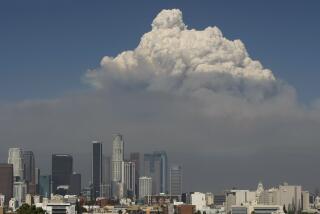As Fires Heat Up, Spokesman Stays Cool
SHOW LOW, Ariz. â For more than a week, the news has been dreadful. The nationâs most destructive forest fire has been roaring through canyons and into wooded subdivisions and small mountain communities, incinerating more than 400 homes and forcing 30,000 people to flee.
Those stricken by the grim news said that at least they found some comfort in hearing it from Jim Paxon, the Texan with the brush mustache who lays out the facts bluntly, sometimes with a lyrical twist, as a spokesman for the U.S. Forest Service.
âHeâs terrific. He tells you exactly how it is,â said Steve Splawm, 79, of Summer Pines, who took refuge at the Red Cross evacuation center in nearby Holbrook. On news programs, he and more than 100 others sit in front of two large TVs for Paxonâs briefings. âHe uses plain language and doesnât sugar-coat anything,â Splawm said.
Like the time Paxon reported, âWe got beat up real bad today,â and later in the week, âI donât mean to be vulgar, but the fire kicked our butts today.â
Daniel Waelrock, 56, of Overgaard, said he appreciated Paxon âfor his ability at storytelling.â
Like Paxonâs explanation of how an inversion layer cooled the fire: âToday was a good day for firefighters. The reason was, if weâre in a kitchen and weâre cooking, weâve got bacon grease in a skillet, and that bacon grease catches fire. If we put the lid on that skillet, it suppresses the fire. It puts it out. This inversion that we had over us all day today essentially was the lid on the skillet.â
Everyone loves Paxon, from reporters looking for good quotes and sound bites to residents wanting the straight scoop. At Round Valley High School in nearby Eagar, messages written to firefighters on a wall around the football stadium included this one: âPaxon for president.â
His value to the Forest Service as a translator of technical news for common folk was recognized in 1988, when he was helping fight several fires in the Yellowstone National Park region that burned more than 3 million acres of public and private land.
âI was out there trying to keep up with the young ones for 31 days,â he said, âand thatâs a long time for an old [guy].
âSomeone said to me, âYou know, you talk pretty good, and youâre getting old and fat. Why donât you become an information officer?â â
Every summer since, he has been pressed into service as a fire information officer.
Today, the 54-year-old Paxon spends most of his time as a district ranger in Gila National Forest at Truth or Consequences, N.M., where he oversees a staff of 50 full-time employees, 30 seasonal ones and 552,800 acres of forest.
But during fire season, Paxon turns gypsy, assigned to a fire incident commander and his staff as they travel from one large fire to the next. Newly married, he has delayed his honeymoon until fall.
Forest Service officials cringe when one of their spokesmen is singled out, but the government accepts that Paxon is a favorite among the national media. Paxon starts his day at 4 a.m. with live interviews for East Coast network news shows and wraps up local interviews at 10 p.m.
âHeâs phenomenal because heâs been an actual firefighter and can translate that job in common words so people can understand,â said George Lennon, the Forest Serviceâs communications director in Washington.
Paxon said heâs not looking for fame. âIâm just a talking head, and itâs important to present an image of firefighters that people can understand.â
Paxon said he resists the temptation to be too upbeat or overly glum about a fireâs danger when homes and lives are at stake. He decided long ago to let the facts speak for themselves. âMy granddaddy told me to stick to the truth, because itâs the only thing you donât have to keep track of.â
Paxon grew up in farm country around Lubbock, Texas, and in college studied animal and range science. He and his buddies fled the flatlands for a weekâs vacation in the mountainous Pecos Wilderness near Santa Fe, N.M., and he grew smitten by trees. He joined the Forest Service as a firefighter in 1969.
By 1981 he was promoted to district ranger and became a forest land manager, but during fire seasons still traveled the country as a fire crew boss. After becoming a spokesman, Paxon learned over and again how tricky the job can be.
During the Los Alamos, N.M., wildfire in 2000 that spread from a prescribed burn, âI told reporters we were doing really well on the fire. When we stepped out of the briefing tent, 60 mph winds kicked up. Within four hours, the fire had grown from 11,000 acres to 38,000, and it burned more than 600 housing units.â
Such unpredictability triggers one of Paxonâs favorite lines: âYou know, when you try to say what Mother Natureâs going to do, she makes you a liar.â
He has alternately described the Rodeo-Chediski fire as a âmultiheaded monsterâ and âfire-breathing dragon.â He justified the 437,000-acre fireâs intensity: âMother Nature canât stand all the congestion in the forest, so sheâs going to start over.â
And when the fire stalled in its march toward Show Low, Paxon explained: âEither the monster was napping and never reared its head or the good Lord blessed us today.â
But ultimately, Paxon said, âfires are won and lost by firefighters. Theyâre the foot soldiers, the ditch diggers.â
*
Times staff writer Steve Berry in Holbrook, Ariz., contributed to this report.
More to Read
Sign up for Essential California
The most important California stories and recommendations in your inbox every morning.
You may occasionally receive promotional content from the Los Angeles Times.










